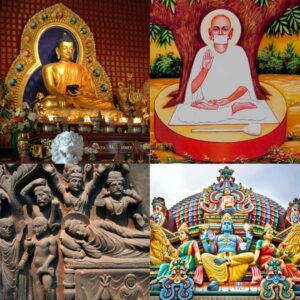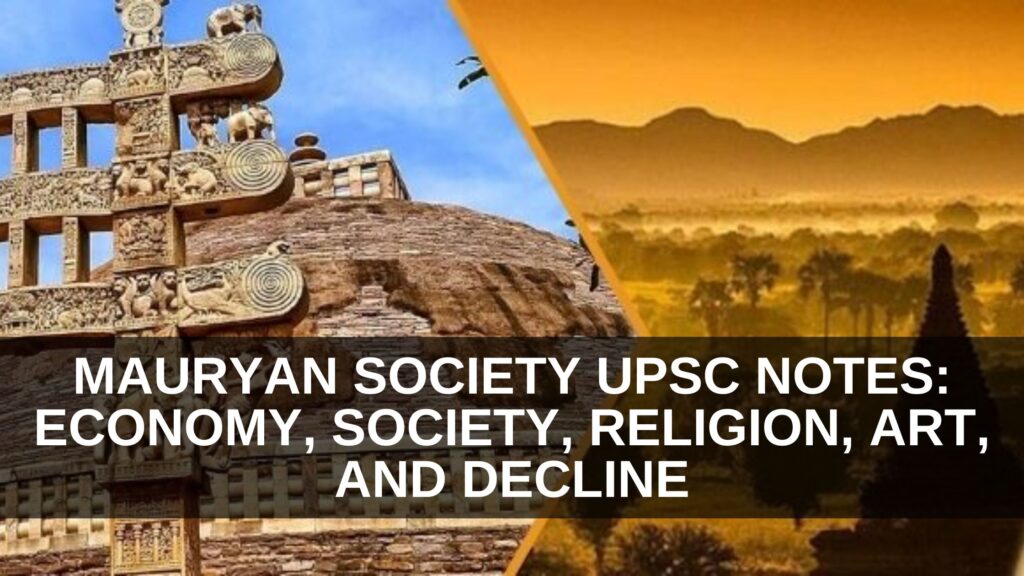The Mauryan Empire (321-185 BCE) was one of the most powerful and expansive empires in ancient India. Under the leadership of Chandragupta Maurya, Bindusara, and Ashoka, it witnessed significant economic growth, social structuring, religious transformation, and artistic advancements. Let’s delve into the intricate aspects of Mauryan society, economy, religion, art, and the eventual decline of the empire.
Mauryan Society Economy
The Mauryan economy was robust, driven by both national and international trade. With the unification of the Indian subcontinent under a single empire, internal trade routes flourished, and maritime trade boomed.
Key Ports and Trade Routes
Several important ports facilitated trade, such as:
- Western Coast: Bharukachch/Bharoch and Supara
- Eastern Coast: Tamralipti (Bengal)
Major internal trade routes included:
- South-West Route: Sravasti to Pratishthana
- South-East Route: Sravasti to Rajgriha
- East-West Route (Uttarpatha): Taxila to Pataliputra, following the Ganga and Yamuna rivers (modern-day Grand Trunk Road)
The Uttarpatha was a pre-Mauryan ancient road further developed by the Mauryans. Megasthenes, the Greek ambassador, noted that Chandragupta Maurya heavily invested in the construction of roads, with an administrative system ensuring their maintenance. Ashoka also contributed by planting trees and constructing wells along the roads.
Read these blogs Religious Traditions in Jainism, Shramana, and Buddhism
International Trade
Trade flourished with the Greeks and Burma. A notable commodity was pepper, referred to as Yavanapriya (‘Adorned by the Greeks’), indicating its high demand among Greek traders.
Monetary System and State Control
Trade was facilitated by metal currency, including silver, copper, gold, and lead coins. The state collected goods as Rajapanya (state goods) through taxation, which were then sold under official supervision.
Society During the Mauryan Empire
The Mauryan society was structured based on the Varna system, despite Greek historian Megasthenes incorrectly categorizing it into seven distinct groups.
Social Hierarchy and Occupations
- Varnas: The society was primarily divided into four Varnas, with restricted intermarriage and hereditary occupations.
- Guilds: Handicrafts such as jewelry, woodwork, and metalwork were organized in professional guilds under a president (Pramukha) and an elder (Jetthaka).
- Position of Women: Women held an inferior status, with growing polygamy and employment in roles such as guards and spies.
- Forced Labour: Known as Vishti, it was forced upon Shudras, who were given land in newly colonized areas. However, this improved their social status.
- Slavery: Slaves were categorized as:
- Dasas (ordinary slaves)
- Ahitaka (mortgaged slaves, forced into labor)
- Karmaharas/Bhritakas (free laborers)
Centres of Learning
Education thrived, with Taxila being a prominent higher education hub.
Religion During the Mauryan Empire
The Mauryan rulers were patrons of multiple religious sects, including Buddhism, Jainism, Ajivika sect, and Hinduism.

Buddhism
- Ashoka’s Conversion: According to the Mahavamsa, Ashoka converted to Buddhism under Nigrodha’s influence.
- Missionary Expansion: He sent his son Mahendra and daughter Sanghamitra to Ceylon to spread Buddhism.
- Third Buddhist Council: Presided over by Mogaliputta Tissa, it was a significant event in Buddhist history.
- Dhamma Policy: Ashoka promoted Dhammaghosa (conquest by Dharma) over Berighosha (conquest by war).
Jainism
- Chandragupta Maurya converted to Jainism, abdicating his throne to live in Shravanabelagola with his mentor Bhadrabahu.
- Samprati, a later Mauryan ruler, was also a Jain patron.
Ajivika Sect
- Founded by Goshala Maskariputra, it believed in Niyati (cosmic determinism).
- King Bindusara and Dasharatha were patrons of this sect.
Hinduism
- Megasthenes equated Shiva with Dionysus and Krishna with Herakles.
- Kautilya described Hindu worship practices, including the offering of flowers and incense.
Mauryan Art and Architecture
The Mauryan period witnessed a transition from wood and clay structures to grand stone architecture.
Pillars
Ashokan pillars, inspired by Persian models but monolithic, were carved from a single stone. Examples include:
- Lauriya Nandangarh: Single lion capital
- Sanchi & Sarnath: Four lions back-to-back (Sarnath Pillar became India’s national emblem)
- Sankisa: Elephant capital
- Rampurva: Bull capital
Sculptures
- Yaksha Statues (Patna)
- Yakshini of Didarganj (Bihar)
- Stone Elephant (Dhauli, Odisha)
Stupas
- Sanchi Stupa: One of Ashoka’s 84,000 stupas, built to enshrine Buddhist relics.
Caves
- Barabar & Nagarjuni Hills: Used as residences for monks.
- Lomasrishi & Sudama Caves: Noted for polished interiors.
Palaces
Excavations at Kumrahar (Patna) revealed Mauryan palaces, similar in design to Persian halls.
You may also like this The Mauryan Empire: Rise, Administration
The Decline of the Mauryan Empire
The Mauryan Empire started weakening after Ashoka’s death (232 BCE), ultimately falling in 185 BCE due to several reasons:
- Civil War: Succession disputes weakened governance.
- Dhamma-Mahamattas: These officials became powerful, overshadowing kings.
- Bureaucratic Breakdown: Inefficient administration led to disorder.
- Brahmanical Reaction: Ashoka’s pro-Buddhist policies alienated Brahmins.
- Economic Decline: The state lost control over metal resources and trade.


